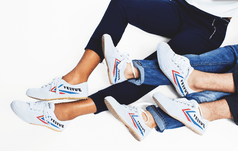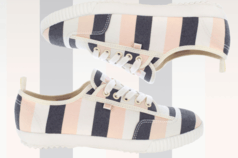Feiyue
Feiyue is a footwear brand established in Shanghai and currently manufactured by two companies;[6] Shanghai-based DaFu Rubber Co., Ltd.,[1] and US-based BBC International, LLC.,[4] which acquired the rights to brandname in 2014.[2][7]
 | |
| Owner | DaFu Rubber Company (Shanghai, China) [1] Feiyue International (Boca Raton, Florida) |
|---|---|
| Produced by | DaFu Rubber Company (Shanghai) [1] BBC International, LLC (Boca Raton, Florida) |
| Introduced | 1958 in Shanghai [2][3] |
| Markets | United Kingdom, United States, China, France |
| Registered as a trademark in | United States (reg n°: 5429834) [4], France, Australia, New Zealand, South Korea, Taiwan by Feiyue International[5] China by DaFu Rubber[5] |
| Website | chinafeiyue.cn feiyue-shoes.com |
Feiyue means "to leap" or "to fly over" but is often translated as "Flying Forward". They first produced in Shanghai during the 1920s. Since 2006 there have been two separate companies creating Feiyue shoes: Da Fu Rubber and its subsidiary manufacturer, Double Coin Holdings, and a French company operating separately from the original Chinese company.[6][8]
Feiyue China shoes were also worn by a number of performers during the opening of the 2008 Beijing Olympic Games, showing that they are still in common use in China. This version is also popular worldwide amongst practitioners of parkour for their light weight, thin sole, and flexibility. Feiyue shoes returned to the spotlight after actor Orlando Bloom was spotted wearing the American version of the shoes, causing a resurgence in interest for the brand.[3][9][10]
The "Feiyue" (simplified Chinese: 飞跃; traditional Chinese: 飛躍; pinyin: fēi yuè) name translates "to leap" or "to fly over." The name at the time of creation was resonant of the Great Leap Forward.[11] The translation and slogan for the American-based footwear brand is "Flying Forward."[3] The Chinese factory has 3,000 employees, with an average 5,000,000 pairs a year s old in that country, with 36,000 pairs produced per day.[6]
History
Feiyue's roots can be traced to the 1920s, when cloth shoes were manufactured in Shanghai.[2] In 1958, DaFu Rubber Company (大孚橡胶厂) designed and produced a kind of civil Jiefang shoe (解放鞋) known as "Feiyue", a modification of the cloth shoes used by the Shaolin monks.[3] They gained popularity during the 30s for their robustness, flexibility and comfort which were considered essential requirements for martial arts and various forms of athletics.[2] The shoes are a staple for almost all wushu practitioners and athletes in China with the shoes even being used by numerous shaolin monks and Kung Fu masters.
In 1963, using FEIYUE and double arrow-labeled chevron with of "Feiyue track and field", the company became the best-selling shoes in China with an output of 1,616,000 pairs. Feiyue continued to be popular for numerous decades, with hundreds of thousands of shoes sold by the original company over the course of its lifetime, continuing to the present day. The shoes are a popular export with numerous foreign martial arts clubs and schools importing them as the standard shoes for their students. With the opening up of China and the associated cultural and economic shifts, the sneaker began to lose prominence in China. Famous indoor football coach Xu Genbao and player Qi Hong participated in contests wearing Feiyue track and field shoes.
In 2005, Patrice Bastian, a marketing and events manager and an entrepreneur living in Shanghai, decided to team up with a group of artists to recreate the brand name with the stated intention of improving the image and appearance of Feiyue. Nicolas Seguy and Clement Fauth were part of his team to redesign Feiyue for the contemporary Western consumer. In February 2006, they launched the first French-designed Feiyue Shoes collection.[2]
The DaFu Rubber Company reorganized and sold the rights to Feiyue to the "Shuang Qian Group Co. Ltd", in 2009. That company would then lease manufacturing back to DaFu and another manufacturer, "Top One" (大博文), both traditional producers of Feiyue shoes.
In 2014, BBC International, the Boca Raton, Florida-based footwear firm acquired the French Feiyue Shoes company.[2] Upon working with BBC, Feiyue's men's, women's and children's collections were updated and globally introduced in Spring 2015. "We've wanted to get into the better vulcanized business for some time, and this is a perfect match for us," BBC Chairman and CEO Bob Campbell said of the brand.
Building on the existing brand, BBC has developed an extensive new collection featuring fashion-forward styling, updated silhouettes, and premium materials such as leather and skins. “We’ve elevated it, given it a fresh approach,” Campbell said. “We showed the line to European retailers for the first time [recently], and the reception was overwhelming. People are excited about the direction we’ve taken with the product. It doesn't look like anything else out there.”[12]
In 2015, BBC International Launched a collaboration with Feiyue and Peanuts for a limited edition collection. Before BBC's acquisition deal in August 2014, Feiyue had major success in collaborations, including collections with Celine, André, Casio, Bonton, NSBQ and more; and continuing with other collaborations beginning with Peanuts.[13]
The American Feiyue company collaborated in 2016 with the Solid & Striped clothing company, with textiles based on Solid & Striped designs.[14]
Intellectual property rights dispute
A dispute exists surrounding the trademark and intellectual property rights to Feiyue between the United States-owned company, Feiyue International, LLC, and Shanghai Da Fu Rubber Co, the company who originally manufactured the shoe. Liu Qinglong, manager of Shanghai Da Fu Rubber Co, said of the situation in 2011, "The French Feiyue brand will never enter the Chinese market…[15] and has called the French Feiyue co-founder Patrice Bastien a "robber."[11]
Patrice Bastian, former co-founder and creative director of Feiyue International, LLC, commented: "It's actually a legal issue and there are many things that we cannot control. The main issue is that many people are claiming the right to this brand in China. So it's very difficult to work with one owner."[6]
According to Bastian, while he was living in Asia in 2005, he became enamored of Feiyue’s white vulcanized shoes.[6] A sneaker collector, Bastien traveled to the factory to buy his own lifetime supply and ended up making a bid to buy the brand (with partners Nicolas Seguy and Clement Fauth), financing the purchase by selling his sneaker collection.[16] However, Da Fu maintains that Bastien made this purchase from a manufacturer and not from them, the original company.[8][11]
Da Fu retains the trademark rights to Feiyue in China, but the US-based Feiyue holds the rights in much of the world, including France, Australia, New Zealand, South Korea and Taiwan.[5] Da Fu took Feiyue International, LLC to court for the rights in France, but lost the lawsuit.[11] As such, the US-based Feiyue retains the rights regarding their trademarks, trade names, brand names, and trade dress, and claim protection by and international laws and treaties.[17]
Distinctions between the Chinese and American versions
The original Chinese versions of the Feiyue shoes and the re-designed American versions have a number of differences. The differences include:
- Sole
- The sole of the Chinese Feiyue shoe contains reduced padding on the bottom of the shoe, which is considered desirable martial arts activities.
- The sole of the French version has thicker padding on the bottom and is designed for more general-purpose use.
- The seal at the center of the sole is a green triangle on the Chinese Feiyue, while the marking is a red circle on the American version. However, recently the Chinese version manufactured by Da Fu has begun to use the American red circle; those manufactured by Top One retain the green triangle.[18]
- Canvas material
- The canvas material of Chinese Feiyue shoe is thin, resulting in a large range of ankle flexibility. The martial arts application requires a wide range of foot motion.
- The canvas material of the American version is much thicker and uses higher quality materials.
- Color
- The original Chinese Feiyues originally came in only two colors, black and white, with a HI and LO version of each. The shoes were previously only available in a limited range of styles—simple stripes with some different colors. The range of colors and style has now grown tremendously both under the American-owned company and the Chinese-owned one, with the BBC International brand offering a wide variety of colors and the Da Fu brand offering a "rainbow" set of shoes.[8]
- Style
- The American version of the shoe offers a wide variety of fashion-forward choices for men, women, and kids. Consequently, collaborations with Céline, Agnès B, and Swarovski followed, as did fans, including Miranda Kerr, Reese Witherspoon, and Orlando Bloom.[19] The Chinese version of the shoe, on the other hand, has around 150 different styles of the shoes catered toward Chinese fashion tastes.[8]
In popular culture
The shoes can also be seen in the music video for Foster the People's "Pumped Up Kicks."[20]
Poppy Delevingne is a fan of the brand, being introduced to it once they arrived in the United States; she has incorporated the shoes into a number of her outfits. [21]
Since joining BBC International Feiyue Shoes has become the Next It-Girl Sneaker. Feiyue has been spotted on Poppy Delevingne and now Whitney Port, who wore the sneakers while out at the Moët & Chandon Suite at the BNP Paribas Open. [22]
Alessandra Ambrosio has sported the popular classic style, the American version, on several photographed outings. [23]
References
- About us on China Feiyue website
- CONVERSE’s recent controversy in China and Chinese sneaker brand‘s comeback on Daxue Consulting, 12 Apr 2019
- Feiyue shoe brand: Two countries, one iconic name by Wang Ying on China Daily, 20 June 2016
- Feiyue trademark by Feiyue International LLC of Boca Raton, FL on Trademarkia
- "Chinese company calls French firm 'robbers' for making Feiyue trainers". South China Morning Post. Retrieved 2019-10-31.
- How Feiyue kung fu shoes are made in China by Lia Yi on GoldThread, Oct 14, 2019
- Our brands on BBC International, 1 Dec 2019
- "How China's Feiyue sneakers, shoes of Shaolin monks, are making a comeback". South China Morning Post. Retrieved 2019-10-31.
- Erin, Clark. "BBC Inks Deal For Sneaker Brand". Footwear News. Retrieved August 4, 2014.
- Deola Adebiyi (June 2013). "Kick Starters". Vertical Floor Magazine. Retrieved 19 April 2016.
- "A 'Flying Leap' in Chinese branding". The Globe and Mail. Retrieved 2019-10-31.
- Clack, Erin. "BBC Inks Deal for Sneaker Brand". Footwear News. Retrieved August 4, 2014.
- Nikara, Johns. "BC International Launching Collaboration With Feiyue & Peanuts". Footwear News. Retrieved July 31, 2015.
- Aemilia, Madden. "Your Favorite Sneaker and Swimsuit lines Teamed Up for a Collab". Who What Wear. Archived from the original on April 19, 2016. Retrieved April 15, 2016.
- Times, Global. "Rebooting the brand - Global Times". www.globaltimes.cn. Retrieved 2018-08-31.
- Bell, Jennie. "Exclusive 5Q with Feiyue Creative Director Patrice Bastian". Footwear News. Retrieved Jan 5, 2015.
- "Feiyue. Conditions of Use". feiyue-shoes.com. Retrieved 2018-08-31.
- "Feiyue Kung Fu Shoes". Retrieved 26 Dec 2019.
- Stern, Claire. "Our New Sneaker Obsession: Feiyue Officially Launches in the U.S. Today". In Style. Retrieved April 16, 2015.
- Mitch, Moxley. "The Chinese Knock Out". Men's Journal.
- Fawnia, Soo Hoo. "Poppy Delevingne Has A Thing For This Under - $100 Wardrobe Staple". The Zoe Report. Retrieved July 13, 2015.
- Carson, Olivares. "Are These The Next It-Girl Sneakers?". Who What Wear. Archived from the original on November 1, 2018. Retrieved May 24, 2016.
- "Alessandra Ambrosio wearing Gucci, Feiyue, RE/DONE and Raen". Fashion Base. Archived from the original on 2018-11-01. Retrieved 2018-10-31.
External links
| Wikimedia Commons has media related to Feiyue. |

